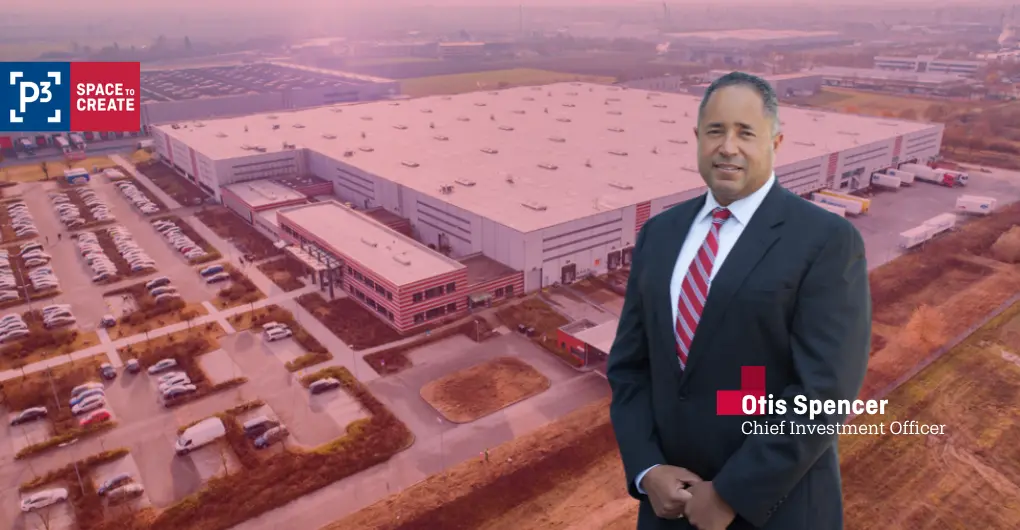

Industrial property values are at record highs, but rising inflation and a predicted economic downturn threaten to reduce the asking price of warehouse assets across Europe, from summer 2022. At the same time, demand for assets is strong due to a lack of investable product. P3’s Chief Investment Officer, Otis Spencer, details a recipe for business success at this “inflection point.”
Why are industrial property values predicted to decline?
“What we’re seeing now is that the market is moving, due to economic uncertainty and the expected headwinds we’re headed into, including inflation, higher financing costs and a low growth period. Therefore, owners reasonably suspect their assets will be worth less six months’ time than what they can secure, right now.”
“One key indicator of this trend is bond yields. What we see is bond yields rising, due to investors demanding higher returns because of increased economic uncertainty. This relates to real estate because there’s a long-term correlation between bond and real estate yields; they grow in tandem. Bonds are a safe investment and property yields are priced off of them.”
“For investors, there’s a lack of product coupled with strong demand. So, we’re at an inflection point for asset values. In this context, there’s a window for capitalising on the very attractive pricing owners think they can get. But it’s closing, as we see bond yields increase.”
But how can owner-occupiers access capital locked inside bricks and mortar, without seriously disrupting their operations?
“We’re seeing a rising interest in sale and leasebacks in the countries we’re active in. A sale and leaseback is a transaction in which an owner-occupier sells a property to a buyer and then stays in the building as a tenant of the new owner, who becomes the landlord. It’s a way to free up significant capital, which is attractive to owner occupiers who are focused on their business and realise the asset has a certain value to a potential buyer. For investors, it’s a way to access high-quality assets when supply is tight.”
What makes a sale and leaseback a good option?
“Sale and leasebacks are a way to create a lot of liquidity, enabling owner-occupiers to take advantage of a market in which their assets have appreciated so much. They may have a higher, better use for this capital, instead of having it all tied up in real estate. Perhaps it’s better to free up that capital to serve the business by investing it, for example in new equipment or other upgrades. On the investor side, sale and leasebacks are a way to achieve profitable growth objectives.”
What are some characteristics of a good tenant-landlord relationship?
“It’s really about structuring the new lease so that it’s mutually beneficial and you achieve the objectives of both the seller and the investor. An owner-occupier doesn’t want some trader who’s going to come in and structure a deal with the focus on flipping [re-selling] the asset, quickly. That’s unlikely to serve the occupier’s priorities. So, an owner-occupier should carefully consider whether a potential buyer has the interest and capacity to be a high-quality landlord, who’s ultimately good for their business.
“Meanwhile, buyers with capability to be high-quality landlords often prioritise location and what can be done with the property in terms of improving its quality, and that of the covenant. For example, P3 recently completed a sale and leaseback deal for a warehouse in Straubing, in Lower Bavaria, Germany, with 41,600 square metres of rental space. We plan to install solar panels and charging stations for electric vehicles there.
“Additionally, if an asset is on a site that allows for expansion, a landlord might also have development capabilities in-house which helps the new tenant to grow their physical presence if they want to.
“An ASTI (above standard tenant improvement) is another feature and is when the landlord finances improvements to a property for the tenant. An ASTI dovetails with a sale and leaseback because it means the occupier doesn’t have to fund the improvements with the proceeds of the sale of its former site. For example, at P3 we can provide capital to improve a facility, not only buy it. Occupiers know we can work with them to facilitate their growth in this way.”
Are sale and leaseback deals simple or complicated to do?
“It depends on the parties involved. If a buyer needs to go to a bank for financing, then that may take months. A typical leveraged buyer has to go and raise funds, either from a bank or from investors, which increases the complexity and time it takes to complete the arrangement. So for owner-occupiers considering a sale and leaseback transaction, an all-equity buyer is ideal because they offer certainty of execution and usually within a shorter time frame relative to buyers requiring third-party financing.”
“For example, at P3 we’re not dependent on third parties to provide capital, which stems from who our shareholder is and also from our track record. That’s because equity buyers have no conditions imposed on them by banks, so the seller can be certain the buyer will execute their side of the deal.”